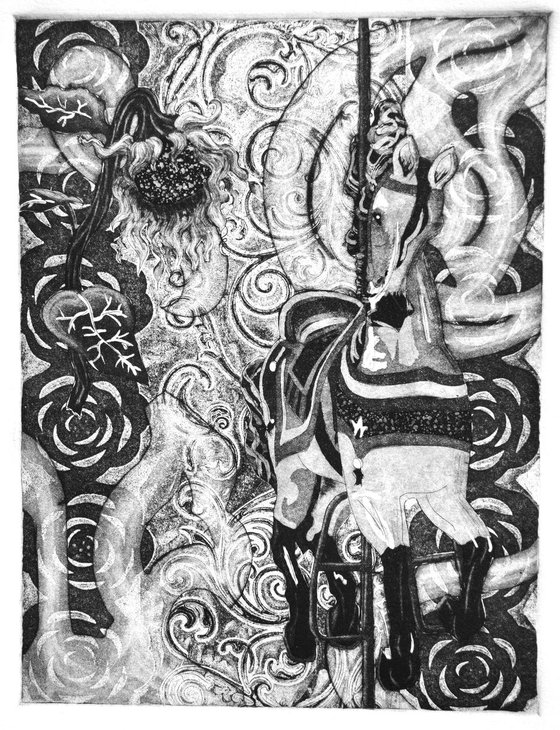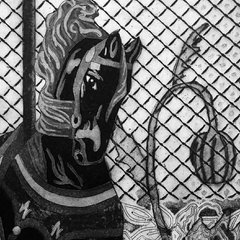- By medium
- By subject
- By budget
- Sales
- Gift cards
- Discover all art
- Artists
- Editors’ picks
- Ideas
Artwork description:
This is the fourth print in the "Carousel" series. It is a hand printed etching on white BFK Reeves paper. The etching image incorporates aquatint, drypoint, and softground etching techniques. As this is a zinc plate etching, the print edition is very limited. Edition size is 20. Each artwork is printed by hand by the artist. Each print is individually numbered and is hand signed by the artist in pencil. It fits in a standard 16 x 20 inch frame.
Etching Process. Etching is traditionally the process of using strong acid or mordant to cut into the unprotected parts of a metal surface to create a design in intaglio (incised) into the metal. In traditional pure etching, a zinc plate is covered with a waxy or hard ground which is resistant to acid. A drawing is transfered onto the hardground, which I then scratch into the ground with a pointed etching needle to expose the bare metal. The plate is then dipped in a bath of nitric acid, which "bites" into the exposed metal, cutting lines into the plate. The remaining ground is then cleaned off the plate. The plate is then etched again to add texture or tonality. The plate is inked all over, and then the excess ink is wiped off the surface, leaving only the ink in the etched lines. The plate is then put through a high-pressure printing press together with a sheet of dampened paper. The paper picks up the ink from the etched lines, making a print. This printing process is repeated until the edition is printed.
Materials used:
ink and paper
Tags:
#horse #pond #etching #equestrian #circus #pony #aquatint #carousel horse #softgroundFeatured by our Editors:
Carousel #4 (2017) Etching / Engraving
by Samantha Shelton
£237.42
- Etching / Engraving on Paper
- From a limited edition of 20
- Size: 27.94 x 35.56 x 0.25cm / 22.86 x 30.48cm (actual image size)
- Signed and numbered on the front
- Style: Illustrative
- Subject: Animals and birds
Loading
Artwork description
This is the fourth print in the "Carousel" series. It is a hand printed etching on white BFK Reeves paper. The etching image incorporates aquatint, drypoint, and softground etching techniques. As this is a zinc plate etching, the print edition is very limited. Edition size is 20. Each artwork is printed by hand by the artist. Each print is individually numbered and is hand signed by the artist in pencil. It fits in a standard 16 x 20 inch frame.
Etching Process. Etching is traditionally the process of using strong acid or mordant to cut into the unprotected parts of a metal surface to create a design in intaglio (incised) into the metal. In traditional pure etching, a zinc plate is covered with a waxy or hard ground which is resistant to acid. A drawing is transfered onto the hardground, which I then scratch into the ground with a pointed etching needle to expose the bare metal. The plate is then dipped in a bath of nitric acid, which "bites" into the exposed metal, cutting lines into the plate. The remaining ground is then cleaned off the plate. The plate is then etched again to add texture or tonality. The plate is inked all over, and then the excess ink is wiped off the surface, leaving only the ink in the etched lines. The plate is then put through a high-pressure printing press together with a sheet of dampened paper. The paper picks up the ink from the etched lines, making a print. This printing process is repeated until the edition is printed.
Materials used:
ink and paper
Tags:
#horse #pond #etching #equestrian #circus #pony #aquatint #carousel horse #softgroundFeatured by our Editors:
14 day money back guaranteeLearn more

